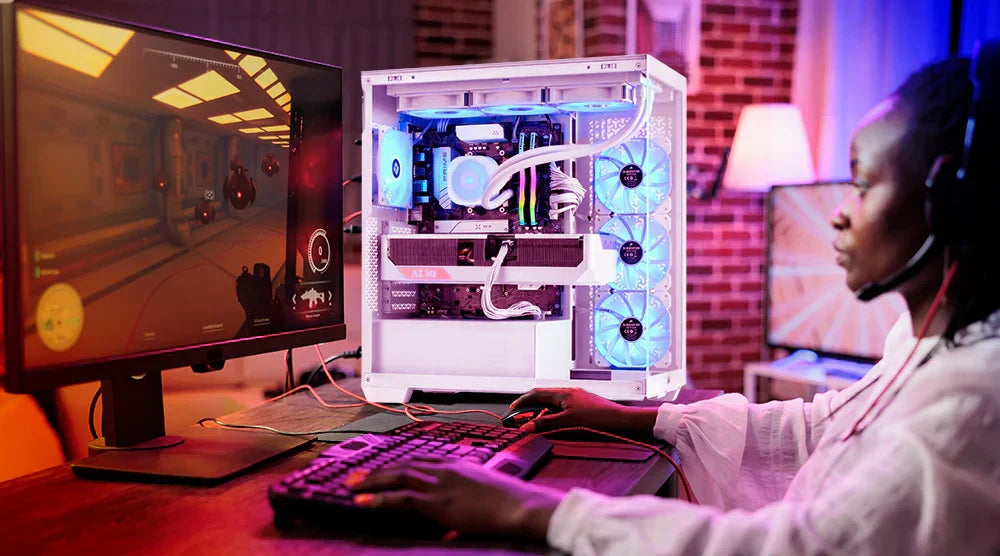Thinking about building your first gaming PC, but not sure where to start?
Custom-built PCs are more popular among gamers than ever in 2025. Building your own gaming rig is more cost-effective, highly customizable, and provides gamers with the satisfaction of creating something unique from scratch.
From selecting the right parts to arranging your tools, step-by-step PC part assembly, and post-build setup, this blog will cover everything you need to know. You will be confident in building your first gaming PC by the end of this brief guide.
Knowing What You Require Before Starting
- Planning beforehand helps you save money and frustration.
- Set a budget, as gaming PCs can cost from $700 to upwards of $3000.
- Understand your playing targets, consider 4K, 1440p, or 1080p gaming.
- Examine the requirements for modern games. Examine the games you wish to play and what hardware is needed. Your decisions will benefit from this.
Key PC Components You'll Need
The most crucial PC components are as follows:
-
CPU (Processor): Your PC's intellect. Either AMD or Intel would be an excellent choice. Pick one that balances speed and cost.
GPU: One of the most crucial components for gaming is the GPU. This regulates your visual quality and smooth gameplay.
Motherboard: A motherboard unites everything. Ensure it suits your PC case dimensions and complements your central processing unit. - RAM: Most games can run on 16GB of RAM (Memory); 32GB is preferable for demanding jobs like streaming.
- Storage: SSDs run quicker than hard disks. Currently, a 1 TB SSD is strongly advised.
- Power Supply: Choose the appropriate wattage, typically 650–750W, with an 80+ certification for safety in a power supply (PSU).
- PC Case: Choose one with enough space for your components and good airflow.
- Cooling: For top-performance builds, liquid AIO coolers are preferable, although air coolers are cheap.
Tools & Workspace Setup
- You’ll need a screwdriver, an anti-static wrist strap, and cable ties for cable management.
- Work on a clean, flat, non-carpeted surface with good lighting.
- Beginners usually take 2–4 hours to build their first PC, so be patient and work carefully.
Step-by-Step Assembly Overview
- On the motherboard, install the cooler, CPU, and RAM.
- Mount the motherboard within the enclosure.
- Link the PSU and cabling.
- Install the GPU and storage drives.
- Organize the cables to ensure proper airflow.
- Carry out a first boot check to check if the computer starts.
Common Mistakes to Avoid
- Forgetting to connect the CPU power wire.
- Placing RAM sticks in incorrect slots.
- Using too little or too much thermal paste.
- Ignoring driver installations and BIOS updates.
Post-Build Setup
Once your computer is constructed, it is time to get it started:
- Go into the BIOS to verify that the system finds all components.
- Linux or Windows Installation.
- Update all major drivers (GPU, chipset, Wi-Fi, etc.).
- Check the temperatures of your CPU and GPU using free monitoring software.
- Launch your first game and appreciate its results.
Final Considerations
With the right strategy, resources, and tools, building your first gaming PC can be one of the most exciting experiences, even though it may initially seem overwhelming. Along with improving performance and saving money, you'll also get useful skills that will benefit you for years to come.
Whether your goal is a high-end powerhouse or affordable gaming, the secret is to plan ahead and build step by step.
Ready to build your dream PC?
Visit Technoid Inc. today and start customizing your dream gaming PC with expert guidance and advanced components tailored to your needs.
Frequently Asked Questions
1. Is building your first gaming PC challenging?
Not quite. Building your first gaming PC is possible if you follow step-by-step guidance.
2. How much should I spend on my first build?
Most beginners invest between $800 and $1500 for a respectable gaming system.
3. May I upgrade later?
Yeah! One of the major advantages of a custom PC is upgrading. The GPU, RAM, or storage may be changed at any time.

 United States
United States

